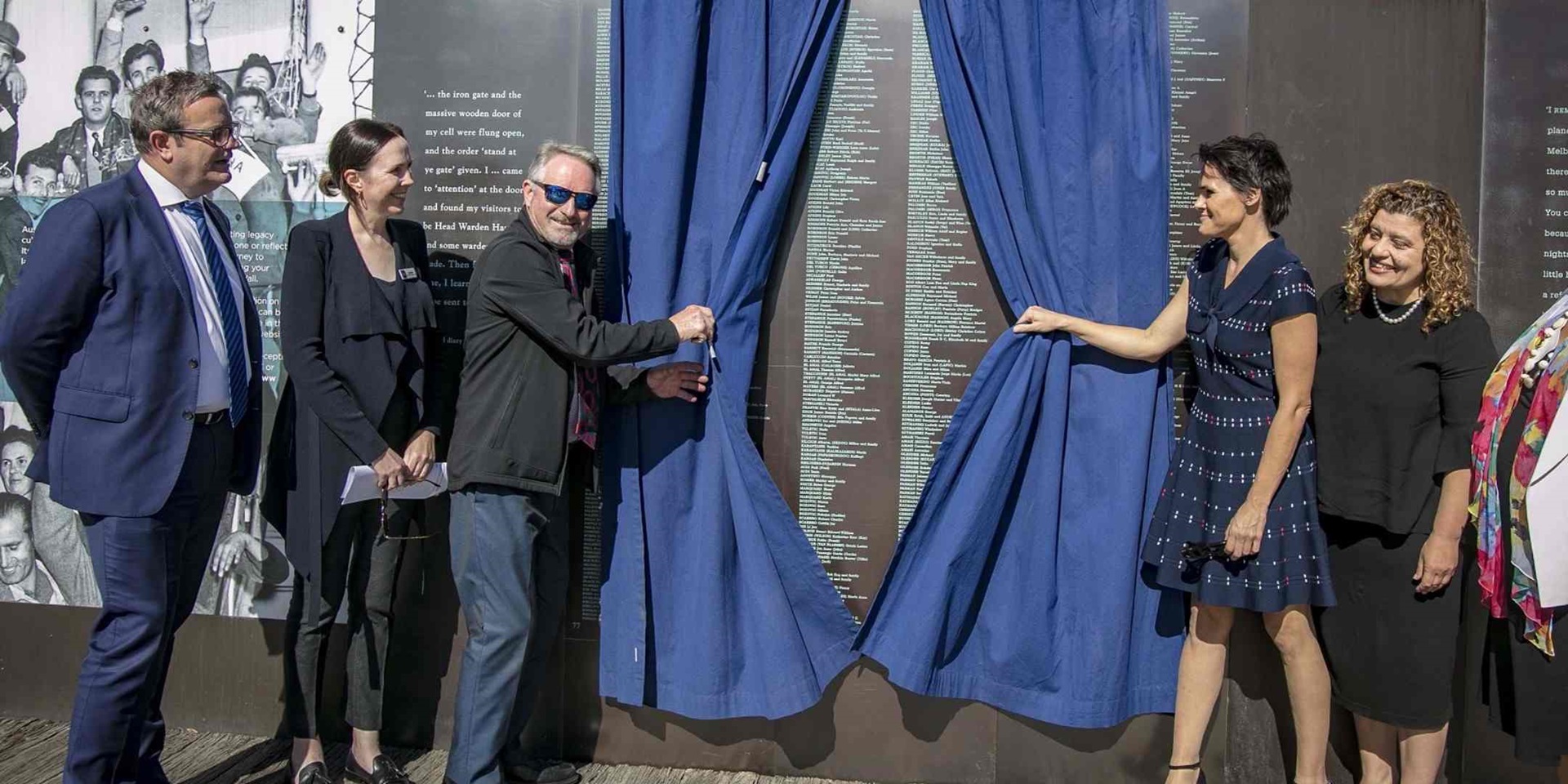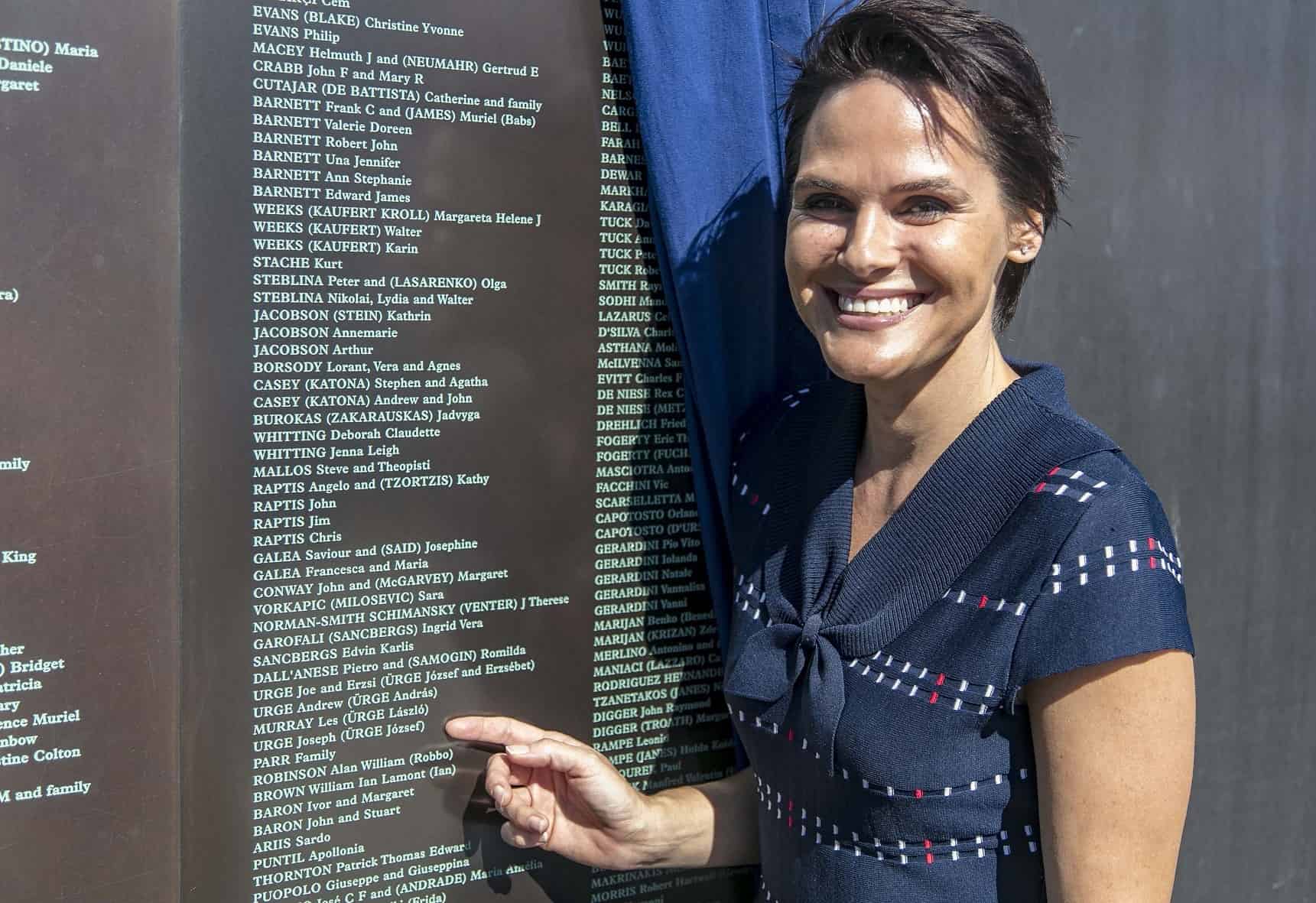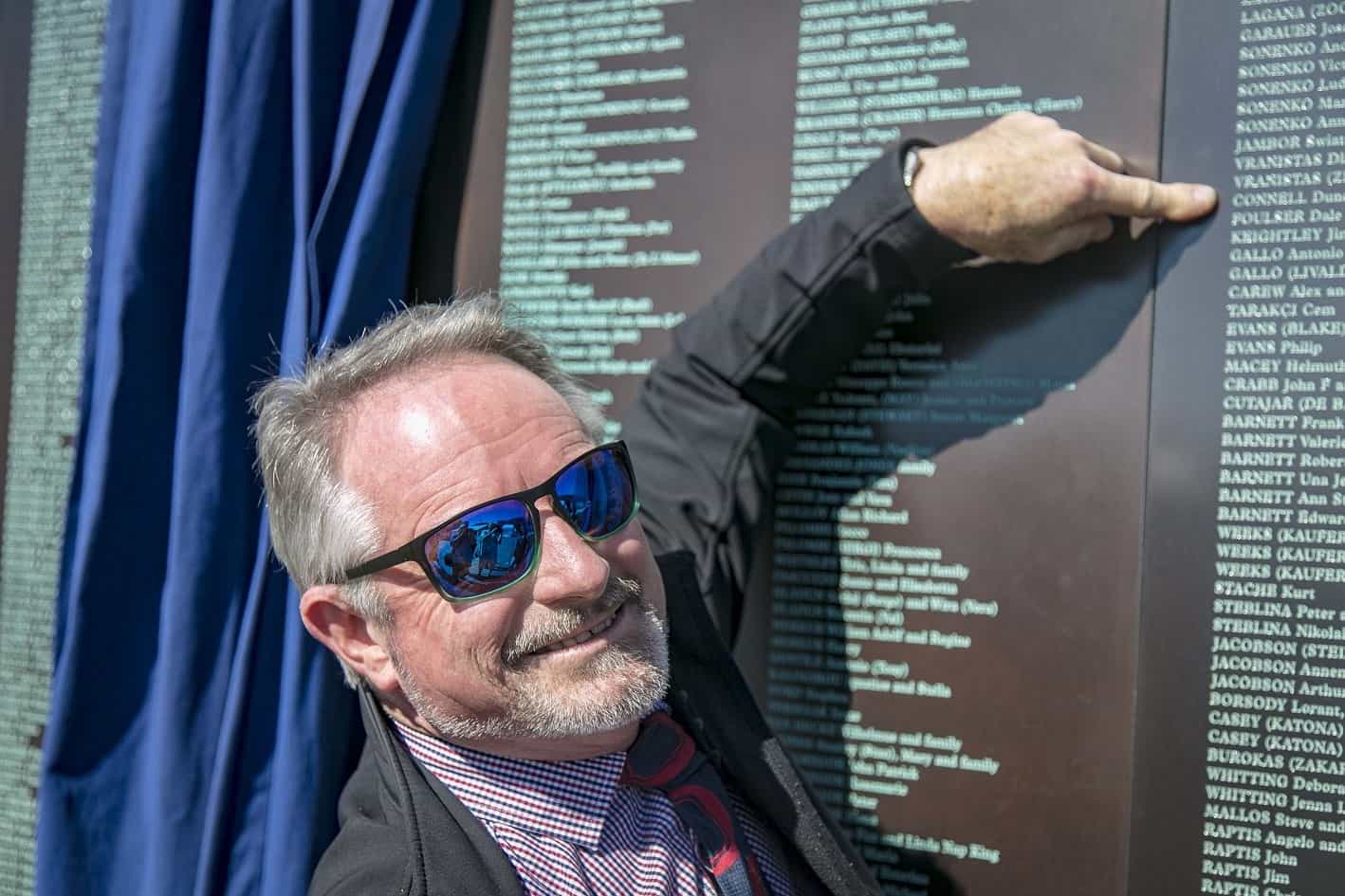
358 names were added to the Welcome Wall during a ceremony on Sunday 6 May 2018. It is the 79th bronze panel added to the Wall and there are now almost 30,000 names on the Wall, which celebrates Australia’s waves of migration. Image: Andrew Frolows/ANMM.
Last weekend the much-loved sports journalist and soccer broadcaster, Les Murray, was honoured by his family to have his name unveiled on the museum’s Welcome Wall. The Welcome Wall pays tribute to the migrants who have travelled the world to call Australia home. More than 200 countries are represented on the Welcome Wall, which faces Darling Harbour and Pyrmont Bay, where many migrants arrived in Australia.
358 names were added to the Welcome Wall during Sunday’s ceremony including families from the United Kingdom, Italy, Greece, Germany, Malta, Hungary, Ireland, South Africa, Croatia, Yugoslavia, Poland, The Netherlands, China, India, Sri Lanka, Ukraine, Latvia, Slovenia, Turkey, Argentina, Cyprus, Czechoslovakia, Estonia, France, Indonesia, Lebanon, Macedonia, New Zealand, Portugal, USA, Austria, Denmark, Fiji, Kazakhstan, Lithuania, Namibia, Russia, Spain and Zambia. It is the 79th bronze panel added to the Wall and there are now almost 30,000 names on the Wall.
It was one of our largest unveiling ceremonies, with over 1000 people in attendance. Guest speaker Ken Shipp, Director of Sport at SBS, reflected on Les Murray’s stellar contribution to Australia, Australian sport and paid homage to the rich and engaging stories of migrants to this country. Les’ daughter, Tania Murray, read an excerpt from By the Balls: Memoir of a football tragic.

It was one of our largest unveiling ceremonies, with over 1000 people in attendance. Image: Andrew Frolows/ANMM.
Mary Lagana, daughter of Giuseppe and Caterina from Calabria, Italy also shared her parents’ story of post-war migration to Australia.
Ian Connell, son of UK migrant Duncan Connell, spoke of his father’s experience as a fitter and turner at Cockatoo Island Dockyard, where he worked on the museum’s own HMAS Vampire and the submarine HMAS Onslow.
Amongst those attending the ceremony to see their name newly engraved on the Wall was 100-years old Mr Vic Facchini, from Trento, Italy, and his family.
Ken Shipp
Australia’s rich cultural diversity is one of its greatest strengths. More than half of us identify as having migrant heritage and one in five Australians speak a language other than English at home.
SBS was established more than 40 years ago and has been and, continues to be integral to successful multiculturalism in Australia. It is the only media organisation dedicated to inspiring a shared understanding, and promoting the value of cultural diversity. SBS continues to be this institution, celebrating our differences and providing a unique perspective and different offering in the Australian cultural and media landscape.
Being a multicultural broadcaster is about more than speaking to Indigenous and multicultural communities. It is about inspiring understanding, encouraging acceptance and sharing the value of culture and diversity with all Australians. One of the ways in which we can bring Australians together in this way is through great sporting moments and one of those great moments every four years is the World Cup. SBS Sport is the spiritual home of football in Australia and the World Cup is a true multicultural celebration that unites Australia’s diverse communities.

Guest speaker Ken Shipp, Director of Sport at SBS, reflected on Les Murray’s stellar contribution to Australia, Australian sport and paid homage to the rich and engaging stories of migrants to this country. Image: Andrew Frolows/ANMM.
We are extremely proud of our Football heritage. As myself and the team prepare to head to Russia for this year’s World Cup, this will be SBS’s first without our beloved Les Murray, a.k.a. Mr Football who sadly passed away last year. Les worked at SBS for more than 37 years and it is an organization with which he became synonymous.
Les was born in Hungary as Laslo Urge. In 1956, at the age of just 11, his family fled the communist nation as refugees, eventually arriving to their new home in Australia, settling in Wollongong. From his humble origins as a refugee, Les went on to become one of the most recognisable and loved sporting legends in Australia.
Les originally started at SBS in 1980 as a Hungarian subtitler. When the network picked up the local football rights, he was destined to take the microphone. Les was a trailblazer for football in Australia. It was a game that he loved and his passion for this sport changed the nation.
The growth, popularity and success of Football in Australia today is absolutely a reflection of his advocacy and passion for the game. He is a true inspiration and was held in the highest esteem in the football world, not only in Australia but globally. He was incredibly proud of his Hungarian origins but he was also a true Aussie.
Les was always grateful for the opportunities he had and for the chance his family was given to start again in this country. His Hungarian heritage remained incredibly important to him: He continued to speak the language, cook the recipes his mother taught him, and of course follow the mighty Magyars, Hungary’s national football team.
Les was always an advocate for refugees and a champion of multiculturalism. In 2011, he returned to Hungary to track down the man who risked his life so that Les and his family could escape. He shared the story with Australians to help people understand more about the plight of refugees, and those who legitimately help them. As a refugee himself, he genuinely embodied and respected what SBS represents.
He was passionate about our mission and our role in helping people understand each other better. And he saw the huge value that sport, particularly football, could be as a vehicle for breaking down barriers and uniting people. Les would be truly honoured to know he was being remembered in this way on the Welcome Wall today.

Tania Murray unveiling her father’s inscription on the Welcome Wall. Les Murray was a passionate advocate for refugees and proud of his Hungarian heritage. Image: Andrew Frolows/ANMM. Tania Murray — Excerpt from By the Balls: Memoir of a football tragic.
A few days later, on 9 December 1956, on a cold winter’s morning, we were shaken awake by my mother. “Wake up. We’re going,” she said. “Going where?” I asked. It was 2am. Much too early for school. “Never mind. Just get dressed. Quick.” Obediently, we moved swiftly in the dead of night. We were hauled, all five of us, onto the back of a truck. It was bitterly cold and uncomfortable. But we sat in silence. The truck took us to one of Budapest’s three major railway stations: the one that services the west, the route to the Austrian border.
Once we were on the train, the penny dropped: we were defecting. We were about to become dissidents. Refugees. For years, I had been listening to my parents talking about getting out, escaping: finding a way to a new life of freedom and some kind of bliss. This was no desperate run for the border. It was a meticulously planned conspiracy.
In early May of 1957, almost precisely six months after we had crossed the border, the word came that we had been accepted by Australia. Joy filled the family. Even if we knew little about the country, we knew that it was democratic, free and safe. We thought of the many relatives and friends we had left behind; and the huge, irreversible step we had taken. We were embarking on a journey of no return; to a land far, far away; about whose language and culture we knew nothing, and where our future was full of uncertainty and mystery.
Those who have been immigrants to a new land will understand this. With immigration, there is a wide variety of dire difficulties and hostilities. A new migrant is a day-to-day stranger in his chosen land: cold, naked and lonely. He has trouble with the language. He is likely to be in a job with lower status and less dignity than that for which he is qualified. He is treated like an inferior. He is probably discriminated against and spoken down to, and may even be the subject of racism.
It is from these things that migrants need an escape and a refuge, at least momentarily. It is why migrants band together and seek their own friends, their own grocers, butchers, dentists and doctors. It is why so-called ghettos are formed.
Yet, contrary to the myth, such ghettos are generally temporary and are rarely forces of permanent social division. They are merely agents of transition, easing the pains of migration and facilitating assimilation. Once the migrant gains confidence, masters the language and the local customs, and gains acceptance, which might be through a second generation, he moves on. He leaves the ghetto and enters his new society as an equal.
Mary Lagana
I am very honoured to speak on behalf of my family today. Like all migrant stories, our parent’s journey is a familiar one but unique and very special to us. Giuseppe (Joe) Lagana left post-war Italy in 1951, to start a new life in Australia. He travelled alone and left all his extended family behind. He sailed on the Lloyd Triestino Ugolino Vivaldi and the voyage took 31 days.

Mary Lagana, daughter of Giuseppe and Caterina from Calabria, Italy also shared her family’s story of her parents’ post-war migration to Australia. Image: Andrew Frolows/ANMM.
Upon his arrival in Australia, he lived in Paddington before later moving to the Fairfield/Smithfield area, to work on a farm. Like many migrants, Joe spoke no English. Despite this, he obtained employment as a labourer with the NSW Railways and later the Water Board. Joe worked many jobs and saved enough money to purchase a property, so his wife Caterina could join him in Australia.
Caterina Zoccali left Italy in 1957. She sailed on Lloyd Triestino Oceania, just as the Suez Canal had reopened and so her voyage only took 30 days. She shared her cabin with another young woman and would later tell us of their trip through the exotic ports of Port Said, Aden, Colombo and Jakarta; seeing the local children diving into the water; eating tropical fruits like bananas for the first time; and the rough seas that made dining on board a truly eventful experience.
Upon arriving in Sydney, Caterina was expecting to see her husband but only saw some people on the wharf, beckoning her to come down – Joe was on his way but running late. They told her that he would be there soon but Caterina refused to disembark until her husband arrived, telling them that she would stay on board until he did or make the return trip to Italy if he didn’t.
Joe finally arrived and went on board to find Caterina in her room. He came up behind her and playfully tugged on her plait and said ‘I’m here now, can we go?’ And with that reassurance, Caterina and Joe left the boat to embark on their own voyage not only as husband and wife, but as new Australians.
Joe took Caterina to their home in Smithfield, and she was pleasantly surprised to find a fully furnished house for her arrival. They had a long and happy marriage, working side by side in the market garden they established at Fairfield. Joe also continued to work as a labourer. They were the proud parents of three daughters and grandparents to two beautiful granddaughters. Sadly their firstborn, a son, died at birth. They both worked very hard to ensure that their family had every opportunity available to them in their new homeland.
In 1991, after a long illness, Joe sadly passed away. After his death, Caterina’s daughters took her to Italy to visit her family for the first time since migrating to Australia. Caterina had left as a young woman and was returning to her homeland after 35 years. She was both excited and anxious to be travelling to Italy after practically a lifetime away.
Caterina was enthusiastically greeted at the airport by numerous family members as soon as she walked into the arrival hall. Some had not even been born when she left. One older man came up and embraced her with tears in his eyes. Overwhelmed Caterina asked ‘Who are you?’, he replied ‘I’m your brother’. They both cried, immensely happy to see each other again but also for the many years lost. After a number of wonderful weeks visiting family and friends, when Caterina told her daughters ‘I want to go home now’, she meant Australia.
As we the take time today to look at the names on the Welcome Wall and honour the stories of our mothers, fathers, brothers, sisters, aunts and uncles – it is important to remember that they were also pioneers, adventurers, philosophers and dreamers who embarked on an unknown and brave journey to a country on the other side of the world. Ordinary people who did an extraordinary thing – and we will be forever grateful that they did.
Ian Connell
My Father, Duncan Connell, was born into the humble surrounds of Glasgow Scotland in 1921 and died here in Sydney in 2005. I remember him saying that as a lad, he and other boys would run alongside the steam trains and beg the engineers to throw them lumps of coal, to feed their families home fires on freezing nights during the years of the Great Depression.
He started work, at age 14, in the Cartwrights Shop of London, Midlands and Scottish Railways (LMS Railways) as an Office Boy. At age 16, it was no surprise he became an apprentice fitter for LMS Railways. At age 20 (1941), he joined the Merchant Navy and served the SS Narkunda (a troop ship), until it was sunk by a dive bomber during World War II. After some hours he was pulled from the waters of the Mediterranean by the minesweeper HMS Cadmus.

Ian Connell, son of Duncan Connell, spoke of his father’s experience as a fitter and turner including working on the museum’s own HMAS Vampire and the submarine HMAS Onslow during their years of active service. Image: Andrew Frolows/ANMM.
He then signed with troopship MV Avorangi and sailed with her till 1946, when he left Aorangi in Hong Kong and signed with MV Palana (a refrigerated vessel, carrying fresh food from Australia to Britain). Then in 1949, while on shore leave in Sydney he went dancing at the Trocadero, in George Street. There he looked into the eyes of Betty Mair… and fell in love. A few days later they were married in the Registrar’s Office at Petersham.
Dad then sailed back to Britain, where he ‘signed off’ and left the Merchant Navy. During the months that followed, he once again worked for LMS Railways until emigrating to Australia aboard the MV Chesire. At that time he wrote: ‘M.V. Cheshire, the ship that sailed me to Australia, my final port of call.‘
In Sydney, he was reunited with his Bride Betty. They moved into the Mair family home at Denison Road, Lewisham and then later moved to Hastings Parade, North Bondi.
Dad went to work at Cockatoo Island Dockyard, employed as a Fitter and Turner. Initially working in the Machine Shop, Turbine Shop and the Floating Dock. Over the years he worked on many Australian Naval Vessels: HMA Ships Manoora, Manundra, Arunta, Melbourne, Sydney, Queensbourgh,Vendetta, Kimbla, Kanimbla, Yarra and finally, Vampire – which is moored here at the museum.
In the 1960s he worked aboard the Triton Class submarines, which were on loan from the British Navy. Their purpose was to train Australians for the upcoming arrival of the new Oberon Class submarines. During the 1970s he recalled working aboard HMA Ships Oxley, Otway, Ovens, Otama Orion and, another part of the museum’s fleet, Onslow. Dad retired from the dockyards in 1984, finishing his working career as a Quality Control Technician.
He loved Australia and the life he made here. I cannot think of a finer tribute to his journey and memory, than to add his name to the Welcome Wall.

From left to right: Ken Shipp, Director of Sport at SBS; Tanya Bush, Deputy Director of the Australian National Maritime Museum; Ian Connell; Tania Murray; Mary Lagana; Donna Ingram, Indigenous Cultural Representative. Image: Andrew Frolows/ANMM.
— Edited by Kate Pentecost, Digital Curator and Sabina Peritore, Project Assistant Welcome Wall. With thanks to Tania Murray, Mary Lagana and Ian Connell for sharing their family stories. By the Balls: Memoir of a football tragic is available at all good bookstores, through Penguin Australia.
Why not add your family to the Welcome Wall?














